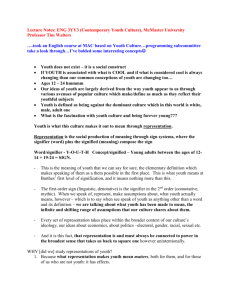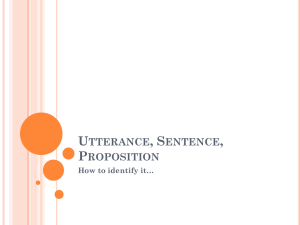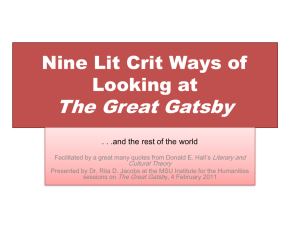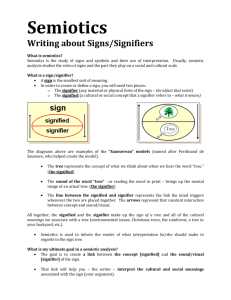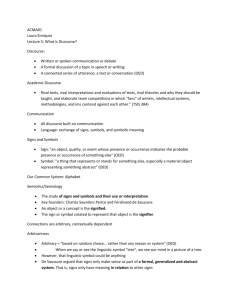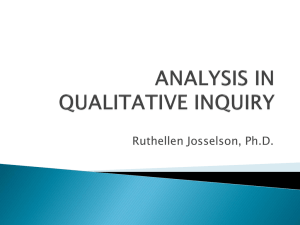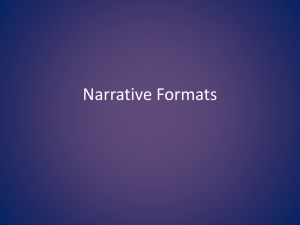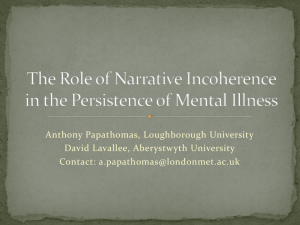Seminar Description
advertisement
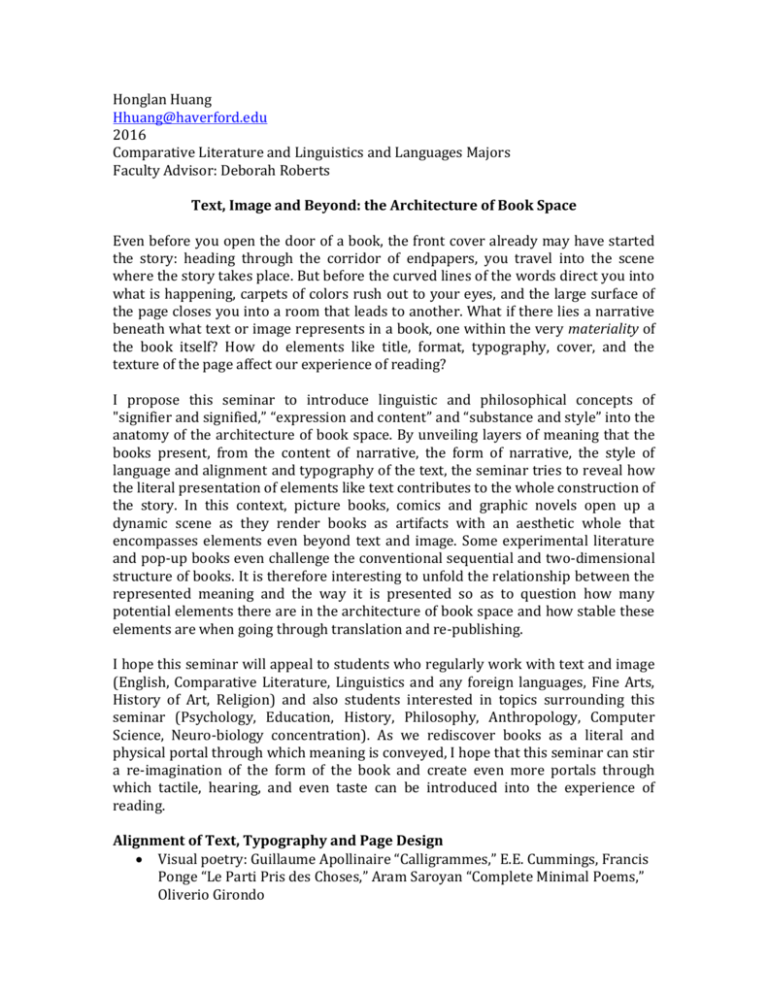
Honglan Huang Hhuang@haverford.edu 2016 Comparative Literature and Linguistics and Languages Majors Faculty Advisor: Deborah Roberts Text, Image and Beyond: the Architecture of Book Space Even before you open the door of a book, the front cover already may have started the story: heading through the corridor of endpapers, you travel into the scene where the story takes place. But before the curved lines of the words direct you into what is happening, carpets of colors rush out to your eyes, and the large surface of the page closes you into a room that leads to another. What if there lies a narrative beneath what text or image represents in a book, one within the very materiality of the book itself? How do elements like title, format, typography, cover, and the texture of the page affect our experience of reading? I propose this seminar to introduce linguistic and philosophical concepts of "signifier and signified,” “expression and content” and “substance and style” into the anatomy of the architecture of book space. By unveiling layers of meaning that the books present, from the content of narrative, the form of narrative, the style of language and alignment and typography of the text, the seminar tries to reveal how the literal presentation of elements like text contributes to the whole construction of the story. In this context, picture books, comics and graphic novels open up a dynamic scene as they render books as artifacts with an aesthetic whole that encompasses elements even beyond text and image. Some experimental literature and pop-up books even challenge the conventional sequential and two-dimensional structure of books. It is therefore interesting to unfold the relationship between the represented meaning and the way it is presented so as to question how many potential elements there are in the architecture of book space and how stable these elements are when going through translation and re-publishing. I hope this seminar will appeal to students who regularly work with text and image (English, Comparative Literature, Linguistics and any foreign languages, Fine Arts, History of Art, Religion) and also students interested in topics surrounding this seminar (Psychology, Education, History, Philosophy, Anthropology, Computer Science, Neuro-biology concentration). As we rediscover books as a literal and physical portal through which meaning is conveyed, I hope that this seminar can stir a re-imagination of the form of the book and create even more portals through which tactile, hearing, and even taste can be introduced into the experience of reading. Alignment of Text, Typography and Page Design Visual poetry: Guillaume Apollinaire “Calligrammes,” E.E. Cummings, Francis Ponge “Le Parti Pris des Choses,” Aram Saroyan “Complete Minimal Poems,” Oliverio Girondo Other cultural traditions with text: East Asian scrolls, “hui wen shi,” Islamic calligraphy Post-modern fictions: William Gass “The Tunnel,” Raymond Federman “Take it or Leave it,” Mark Z. Danielewski “House of Leaves” Text to be discussed in details: The Life and Opinions of Tristram Shandy (Norton edition, Visual Editions, Martin Rowson illustration version, film adaptation: “Tristram Shandy: A Cock and Bull Story”), Picture books: Le Loup ou y-est-t-il, The Song of Robin Hood Theoretical texts: Johanna Drucker “The Visible Word: Experimental Typography and Modern Art,” “The Alphabetic Labyrinth: The Letters in History and Imagination,” “Figuring the Word: Essays on Books, Writing, and Visual Poetics” Relationship between Text and Image Inter-texuality, allusion: picture books of Anthony Browne Figurative language, signifier/signified: photo albums, surrealist picture books Narrative discontinuities: picture books of John Burningham Text to be discussed in details: Alice’s Adventures in Wonderland (Wordsworth edition, Modern Library edition, Yayoi Kusama’s adaptation and the earlier manuscript: Alice’s Adventures Underground) Theoretical texts: Roland Barthes “Image-Text-Music,” Louis Hjelmslev “Prolegomena to a theory of language,” Chatman “Story and discourse” Color, Size, Texture and Style of Image Frame of image: “Keeruline Lugu,” “The Garden of Abdul Gasazi,” “The Powerful Wind,” “You’ll Soon Grow, Alex,” picture books by Jan Brett Size of image: graphic novels such as “The invention of Hugo Cabret,” “The Arrival,” picture books such as “Dawn,” “Dorwroeschen,” “Der Bar, der ein Bar bleiben wolte” Multiple layers of signifier/signified: “Lon Po Po,” “All in a Day,” the phenomenon of “continuous narrative”: Satoshi Kitamura Focal point: “The Napping House,” “Voices in the Park,” “Round Trip,” “Upsidedowners” Blank page, negative space: “Owl Moon,” “The Three Pigs,” “When the Wind Blows,” “Let’s Be Enemies” Color: “Into the Forest,” “The Happy Day,” “Hildilid’s Night” Theoretical Text: David Batchelor “Chromaphobia,” Maria Nikolajeva “How Picture Books Work,” Perry Nodelman “Words about Pictures” Paratext: Endpapers, cover, title, format Title, Endpaper, Title paper Format, spread: “Tudo Depende,” “Moon Boy” Cover, Back cover: Annegert Fuchshuber “Mausemarchen-Riesengeschichte” Tip-in, Gatefold: “Papa, Please Get the Moon for Me” Gutter, line of binding: Shingu “Strawberries” Text to be discussed in details: how paratext contributes to the metafictional construction of the book, Jon Scieszka “The Stinky Cheese Man and Other Fairly Stupid Tales,” “Das Buch im Buch im Buch,” “The Red Book” Other Book Design Elements: die-cut, pop-ups and interactive literature Reading sequence: Cortazar “Rayuela,” “Composition No.1,” “The Unfortunates” Solander case, slipcase: Chris Ware “Building Stories” Die-cut, flipbook: “Tree of Codes,” “Go away, Big Green Monster,” “Very Hungry Caterpillar,” “Le Livre qui avait un trou,” “The Book Mice” Three-dimensional pop-up book: “The Red Dot” Other design elements: artists’ books, Keith Smith Theoretical text: selected articles from Journal of Artists’ Books, Johanna Drucker “Graphic Design History: A Critical Guide,” Alison Gibbons “Multimodality, Cognition and Experimental Literature” *The works listed above are only part of a larger list. We will be discussing a more detailed reading list later so that participants can also bring up examples and issues that are related to these topics. Possible Speakers: David Weisner, American Caldecott winner of picture books, who often engages meta-fictional elements in his recent works Chris Ware, American comic book artist, who builds a distinctive visual language as well as a unique thinking on book form Johanna Drucker, both a book artist and a visual critic, who actively participates in the re-imagination of book space
